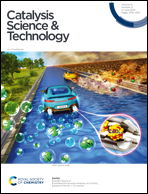A study on the acidity of sulfated CuO layers grown by surface reconstruction of Cu2O with specific exposed facets†
Abstract
Three cuprous oxide samples with exposed {111}, {100}/{111} and {100} facets were synthesized and then oxidized in air by calcination to form surface reconstructed Cu2O@CuO samples. 31P MAS NMR with trimethylphosphine as the probe molecule was applied to characterize the surface acidity of the samples. It was found that the Cu2O@CuO samples exhibit higher Lewis acid density compared with pristine Cu2O samples. After sulfation, the SO42−/Cu2O@CuO samples have similar total acid density, which is much higher than that of Cu2O@CuO samples. Moreover, three types of Lewis acid sites assigned to unsaturated 2-coordinated Cu sites, unsaturated 2-coordinated Cu sites bonded to SO42− and unsaturated 3-coordinated Cu sites were observed on SO42−/Cu2O@CuO. The density of these three Lewis acid sites varies from different samples. In the Pechmann condensation reaction, it was observed that strong Lewis acid sites are deactivated due to adsorption of the reactants while moderate Lewis acid sites act as the actual active sites.



 Please wait while we load your content...
Please wait while we load your content...